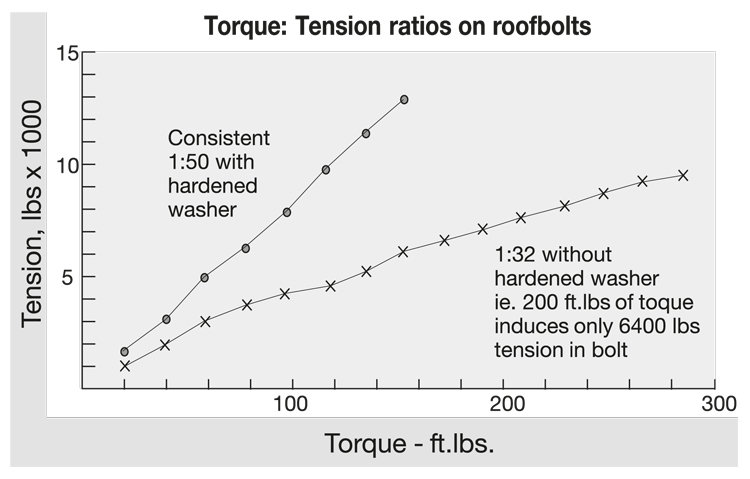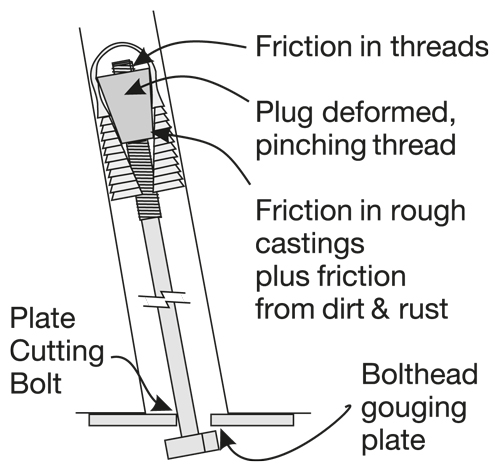Mechanical Rock Bolts
The following are items to be aware of when installing mechanical rock bolts (forged head and threaded both end [TBE] bolts):
Type of Ground - The nature of the ground must be evaluated. Soft strata requires a larger plate washer and/or expansion shell bearing area. Greater expansion of the expansion shell leaves may be required. Soft ground results in larger hole sizes for a given bit size (bit rattling and reaming). Special anchors are available for soft ground. Excessively hard ground can be detrimental as well. Hard ground can result in poor anchorage as the shell is unable to “bite” into the rock.
Scaling - The ground should be thoroughly scaled i.e. barred down, before drilling and bolting. Periodic re-scaling may be required while drilling.
Strength and Yield Capacity of Bolt - The mechanical properties of the bolt should be appropriate for the ground conditions, bolt length and bolting pattern. Pull tests and torque-tension tests should be performed to determine yield strengths and anchorage capacities of the bolts being used.
Oversize Holes - Holes 1/8" oversized can reduce holding strength by 70%. Oversized holes can be caused using the wrong bit size, leaving the drill running while flushing the hole, soft ground (faults, gouge, etc.) and bent drill steel.
Undersized Holes - Undersized holes will not permit the plug in the expansion shell to seat properly. The leaves or bail can break and distort upon forced entry. Undersized holes are usually caused by worn bits and/or wrong bit sizes being used.
Friction Flair Expansion Shells - A recent improvement in expansion shell design is the addition of flairs or wings on the bail strap at the bottom of the leaves. Installation is improved as there is no need to set the anchor to keep the bolt from sliding out of the hole during installation. The anchor sets up faster as the plug engages the leaves freely. Spinning of the anchor in the hole is prevented, thereby eliminating the principal cause of bolt failure upon installation.
Condition of Threads - Threads should be inspected before installation. Increased friction on the threads adversely affects the torque tension relationship.
Fillet on Forged Head - Forged head rock bolts should be inspected to ensure a fillet of 1/8 " radius is present where the shaft connects to the forged head. Sharp transitions may weaken the bolt.
Hole Length - Holes too short for the bolt in use may cause the shell to distort or inhibit proper tensioning of the bolt. Good practice suggests that the hole length should be equal to the bolt length plus shell length.
Hole Condition - The hole should be cleaned and examined to ensure the bolt will insert smoothly. Damage to the shell may result if it must be forced into the hole.
Resin Anchors - Using a resin cartridge to assist in anchoring mechanical rock bolts is gaining popularity. If used with an expansion shell, the shell must have provisions for the passage of resin around the shell wedge. This ensures proper encapsulation of the expansion shell without causing any damage to the assembly.
Expansion Shell Plastic Sleeve - The plastic sleeve holding the leaves together on an expansion shell should be removed prior to installation. If left on it could result in poor anchorage.
Set Up of Expansion Shell - Immediately prior to installation the expansion shell should be set to the correct diameter to enable the bolt to be pushed up the hole by hand, set and anchored. If not expanded enough there will be difficulties in anchoring. If expanded too much the end of the bolt can break the bail or leaf attachment prior to the leaves being set.

where
P = bolt tension (lbs),
T = torque (ft-lbs),
C = 50 for 5/8" forged head bolts
C = 40 for 3/4" forged head bolts
(add 10 to C if hardened steel washer or hemispherical washer is used)











